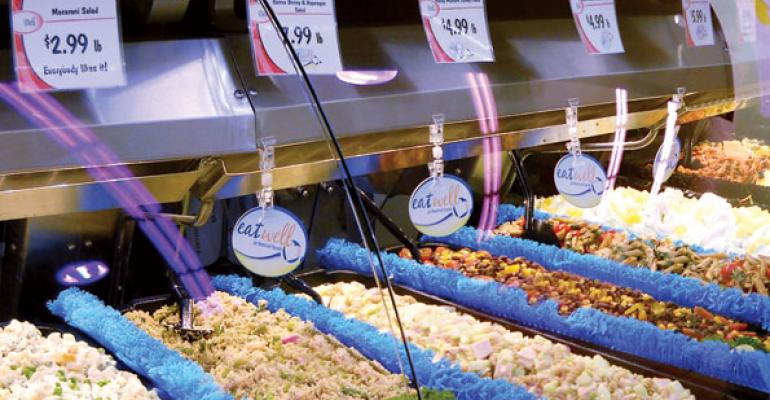That’s the rub — to keep healthier versions of popular dishes tasting great. It’s a job for nutritionists, dietitians, chefs and a computer-savvy team working together. Sometimes brand new items are the answer.
McCaffrey’s, an upscale three-unit, independent supermarket, based in Langhorne, Pa., has been working on making healthier versions of many of its prepared foods for a long time. But, it was just in the past couple of weeks that the company formally launched its “Good Health, Great Taste” program with the help of nutritionist Jill Kwasny, and coordinators, who among other things, created a database and a new labeling system, working closely with corporate chefs.
Others retailers, including Festival Foods in Wisconsin, have debuted similar programs. Such activity — to a large extent — is customer-driven.
“We know that a large segment of our customers has made a total commitment to eat healthy, and an even larger segment will eat healthy if given that choice, and they don’t have to sacrifice flavor or taste to do so,” Jim McCaffrey, owner and president of McCaffrey’s, told SN.
“We think this new program will appeal to both segments.”
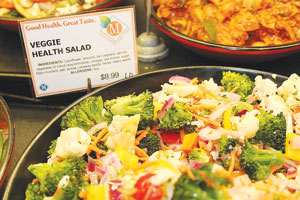 Veggie health salad, mixed grilled vegetables, turkey London broil, grilled marinated chicken, and orzo salad with grilled veggies are just some of the prepared items at McCaffrey’s that meet the criteria set by the company’s new Good Health, Great Taste program. The program designates foods that are low-calorie, low-sodium, low-fat and otherwise have particularly healthful aspects.
Veggie health salad, mixed grilled vegetables, turkey London broil, grilled marinated chicken, and orzo salad with grilled veggies are just some of the prepared items at McCaffrey’s that meet the criteria set by the company’s new Good Health, Great Taste program. The program designates foods that are low-calorie, low-sodium, low-fat and otherwise have particularly healthful aspects.
Kwasny has been working on a consulting basis for McCaffrey’s for years, and recently was brought aboard to work with Chef Jean Pierre and computer analysts/coordinators Wendy Wallace and Fran McElroy to launch the full-fledged healthy eating program.
The analyses and the taste testing have taken a year.
“We wanted to get everything right as we went along,” Kwasny said.
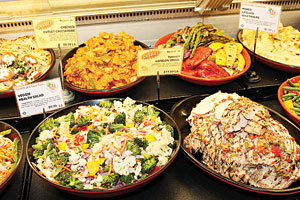 “When we claim a particular item is low in fat or low in sodium, for example, we’re using definitions and recommendations from the American Heart Association and the Academy of Nutrition and Dietetics [formerly the American Dietetic Association].”
“When we claim a particular item is low in fat or low in sodium, for example, we’re using definitions and recommendations from the American Heart Association and the Academy of Nutrition and Dietetics [formerly the American Dietetic Association].”
Jim McCaffrey initiated the new program.
“He wanted a really healthy program that would meet the needs of our customers, but he wanted one that we developed ourselves,” said Fran McElroy, scanning coordinator.
The program saw its official debut a little over a week ago in the company’s ad circular. In-store signage and colorful banners, designed by marketing manager Kathy Bodine, helped with the kick-off.
In each of its stores, a large orange and blue vinyl banner hangs vertically from a stand near the front of the store. Bearing the logo, it directs customers to check out the variety of Good Health, Great Taste items in the deli. Once they’re there, customers are given a handout that explains the program and its purpose. They’re also directed to the company website for more information.
The week of March 19, McCaffrey’s conducted an in-store “dry run.” Associates, as they explained the program, offered customers tastes of some of the new menu items, and collected feedback. Barley fiesta corn salad was a customer favorite.
“We have a lot of variety that we can rotate in and out, and we have at least 10 to 15 of the [newly formulated] items in the service case every day. Next on the agenda is to have some whole meals available — an entree with two sides — and further down the road, the program will include items for the grab-and-go case,” Kwasny pointed out.
One of the biggest challenges in the development of the items was making sure the quality of taste remained when the sodium and fat were reduced. New items were added.
Mashed cauliflower with some seasonings was an early trial in the chef’s case. It’s still being modified.
One thing the development team learned was that customers don’t want their old standby comfort foods tinkered with.
“We learned early that they don’t want us messing with their mashed potatoes or their mac and cheese. We can add bacon to their mac and cheese but that’s it,” said McElroy.
McElroy, who’s a McCaffrey’s veteran of 12 years, stressed that programs such as this one had worked because everybody works so well together.
“We’re a team.”
The huge effort has Jim McCaffrey’s full support.
“I’m excited to introduce this program as an addition to our educational classes that Jill Kwasny conducts in our stores,” Jim McCaffrey said last week.
Kwasny and Chef Jean Pierre orchestrate educational events in-store at least monthly. The most recent focused on the importance of carbohydrates in one’s diet and the next will zero in on proteins and how important they are to maintaining a healthy body.
Meanwhile, in Onalaska, Wis., 16-unit Festival Foods also gave a formal send-off last month to a healthier eating program in its prepared food department.
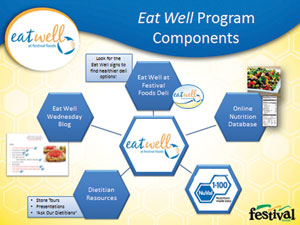 Called “Eat Well with Festival,” the program incorporates a facet that’s makes it particularly a standout. Festival has not only created a database of foods that fall into their better-for-you category, they’ve taken their program a step further.
Called “Eat Well with Festival,” the program incorporates a facet that’s makes it particularly a standout. Festival has not only created a database of foods that fall into their better-for-you category, they’ve taken their program a step further.
They company is working on assigning a NuVal score for each of its store-prepared foods that are in line with the program.
“As far as I know, we’re the only one in this market who is doing that. I know we’re one of the first retailers to submit prepared food products’ criteria to NuVal for a score,” the independent’s health and wellness director, Stephanie Walker, told SN last week.
The company has employed the NuVal system in other parts of the store since the summer of 2010.
“We began adding onto it wherever we could right away, and we want to extend it to every department of the store,” Walker said
“As part of the new Eat Well at Festival Foods program, we’ve developed 10 new deli salads, all of which meet specific nutrition criteria.”
Those criteria include calorie controlled, limited saturated fat, limited added sugar and sodium, trans fat free, and made from 100% whole grains when whole grain products are used.
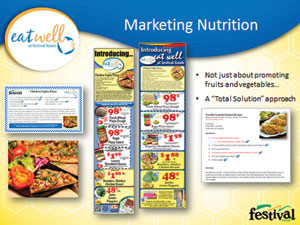 Walker is taking the opportunity on Whole Grains Sampling Day, April 4 — which is orchestrated by Boston-based Whole Grains Council — to demo two of Festival’s new deli salads. Festival is using multiple means to get the word out to consumers about its Eat Well program.
Walker is taking the opportunity on Whole Grains Sampling Day, April 4 — which is orchestrated by Boston-based Whole Grains Council — to demo two of Festival’s new deli salads. Festival is using multiple means to get the word out to consumers about its Eat Well program.
“We’ve hired another dietitian so we can conduct more community events,” Walker said. “Over the last year, we’ve been all over the state of Wisconsin, conducting more than 120 events to tell consumers, among other things, about our program, show them how to use the NuVal program, and to answer their questions about nutrition.”
Walker said one of the important points her team demonstrates is that eating well is not very expensive, thus quelling a myth to the contrary that exists in the marketplace.
Probably the biggest challenge was creating a database of foods that fit the program, Walker said. “It took forever. Well, about 10 months.”
But now there are more than 1,000 items in the database and they’re rotated in and out of the prepared food service case. Trial and error has begun.
“We were really excited that one our new dishes earned a 70-plus NuVal score, but unfortunately it was not a customer favorite.”
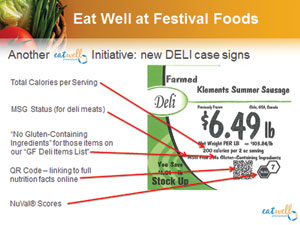 It was a salad containing quinoa, shrimp and asparagus. As Walker pointed out, “many people are not familiar yet with the grain quinoa, and asparagus and even shrimp are acquired tastes.”
It was a salad containing quinoa, shrimp and asparagus. As Walker pointed out, “many people are not familiar yet with the grain quinoa, and asparagus and even shrimp are acquired tastes.”
Another item, lime and black bean fiesta salad, with a NuVal score of 50, was very well received.
The company uses its circular to advertise the program and coordinates a blog every Wednesday with whatever prepared food item is featured in the ad.
In fact, Festival is making good use of technology and social media to get the word out. Signage and other materials direct customers to the company’s website for additional information. Product cards that carry the Eat Well logo also carry QR codes for smart phones.
Hard sales figures for the newly introduced Eat Well items in prepared foods have not been compiled yet, Walker said.
“We’re seeing people’s awareness increasing but that’s just from observation. We will soon be looking at sales figures to see if customers trade up to Eat Well items.”
Walker reports — as do team members at McCaffrey’s and at other retailers — that customer feedback about such programs has been very positive.
One interesting instance of customer feedback is reported by Kowalski’s Markets, St. Paul, Minn., a family owned independent that has had a “Good Food for Good Health” program in place for quite a while. That program keeps calories at 300 or under and limits amounts of fat and sodium in specific prepared foods, which are merchandised in grab-and-go cases as well as the deli service case.
“Just recently, one of our customers told me she lost 30 pounds in 12 weeks by eating only our ‘Good Food for Good Health’ entrees, sides and salads,” said Terri Bennis, vice president of fresh food operations, at nine-unit Kowalski’s.
“I thought that was pretty dramatic. It reminded me of that Subway guy who lost weight eating only Subway sandwiches.”

